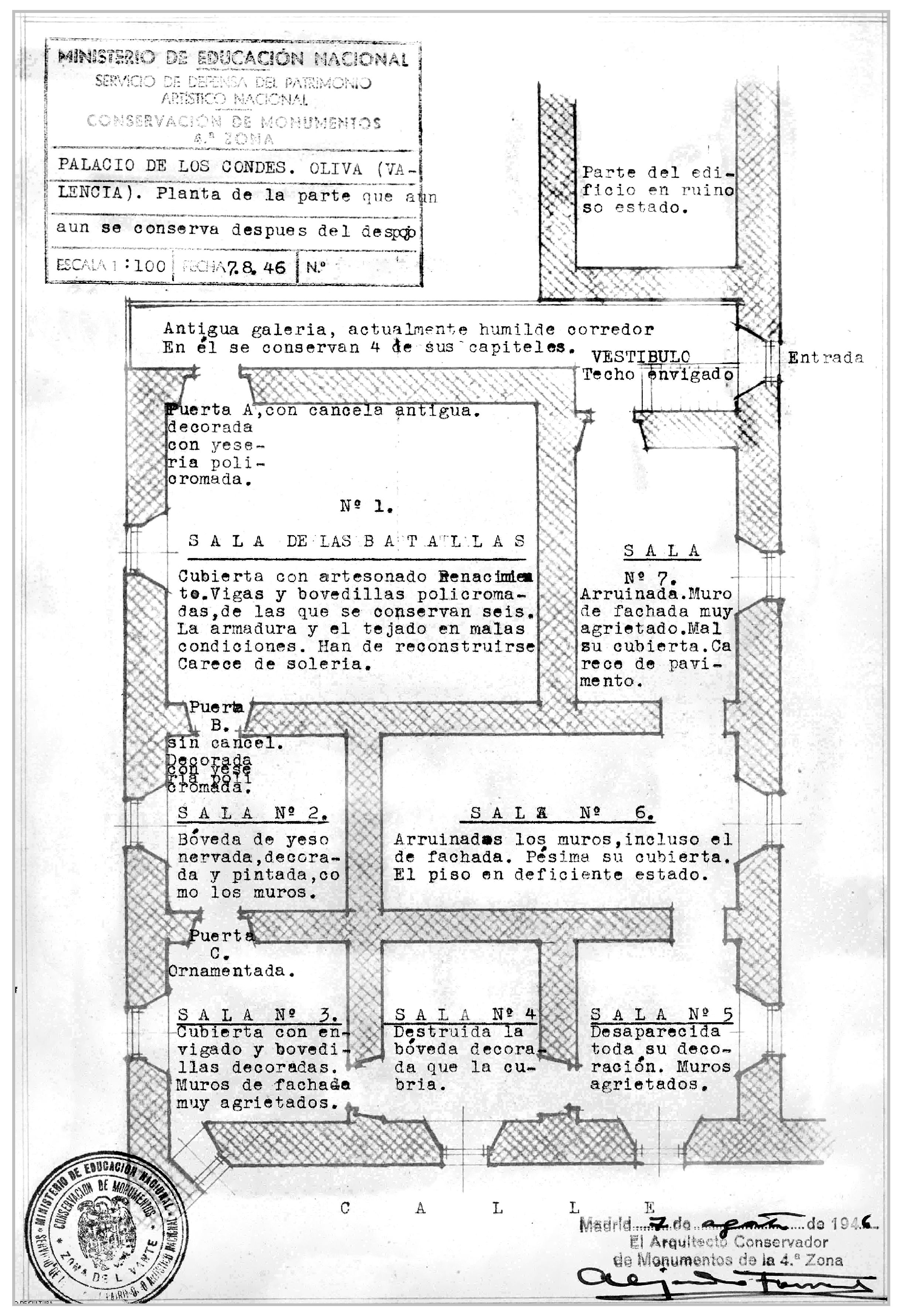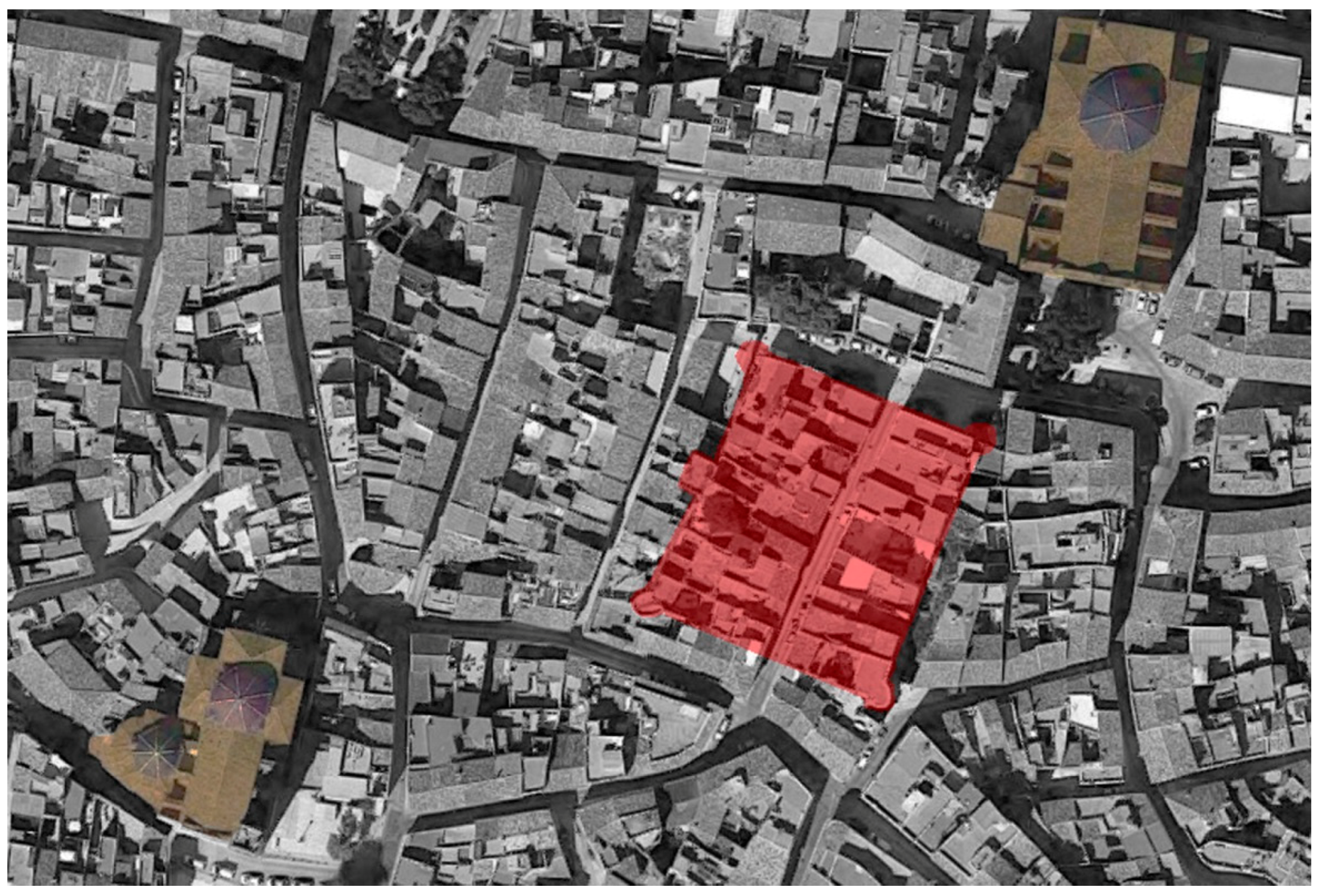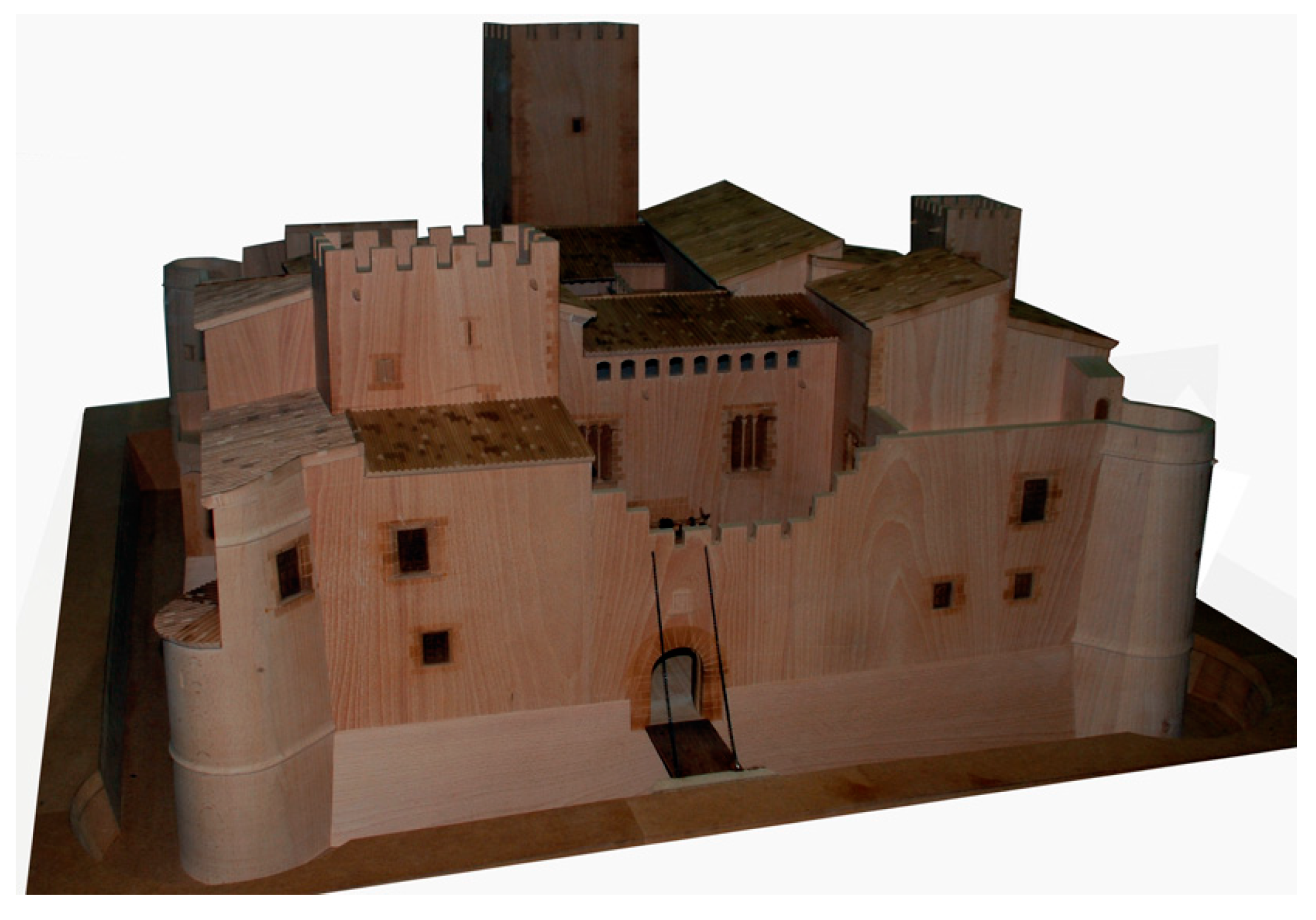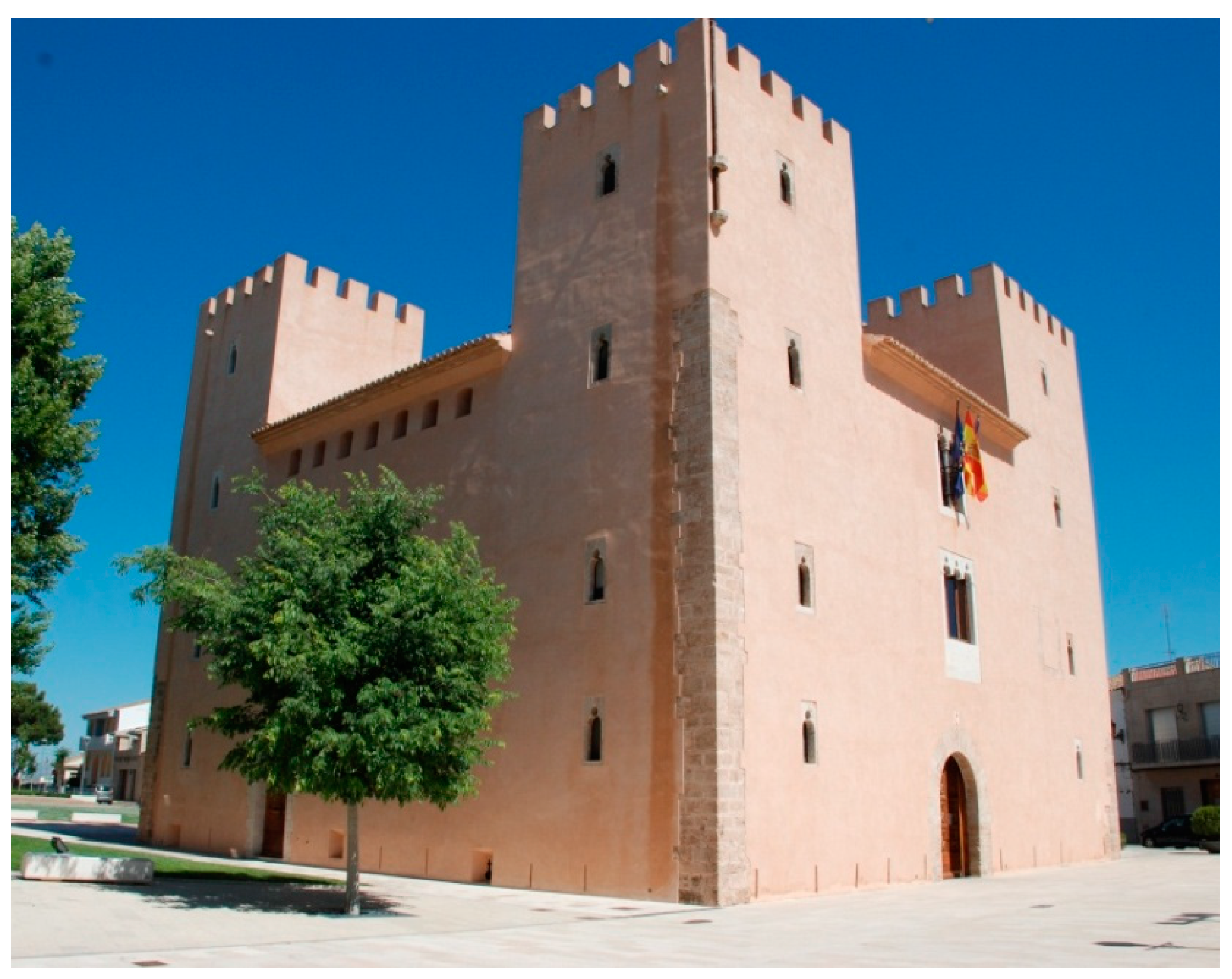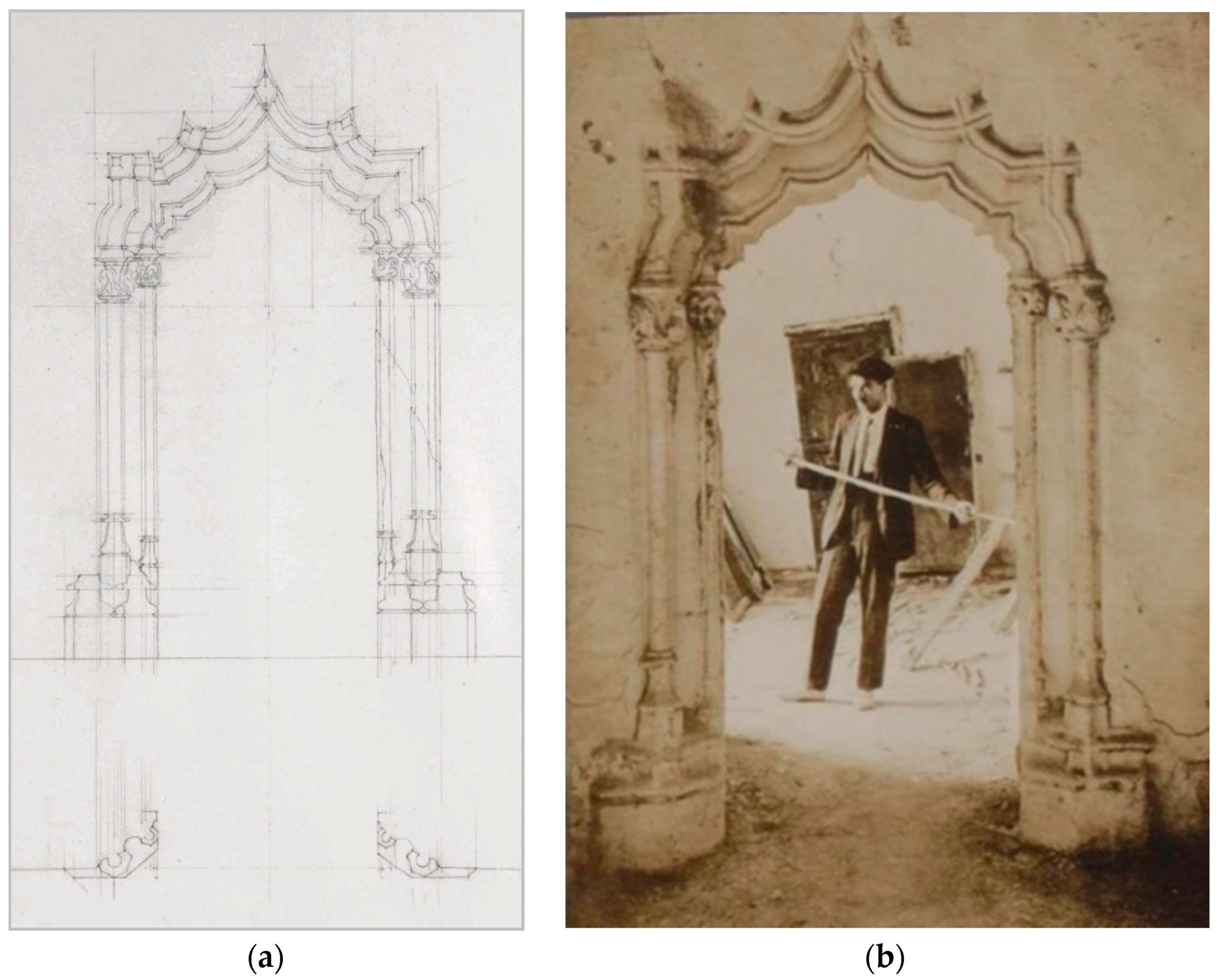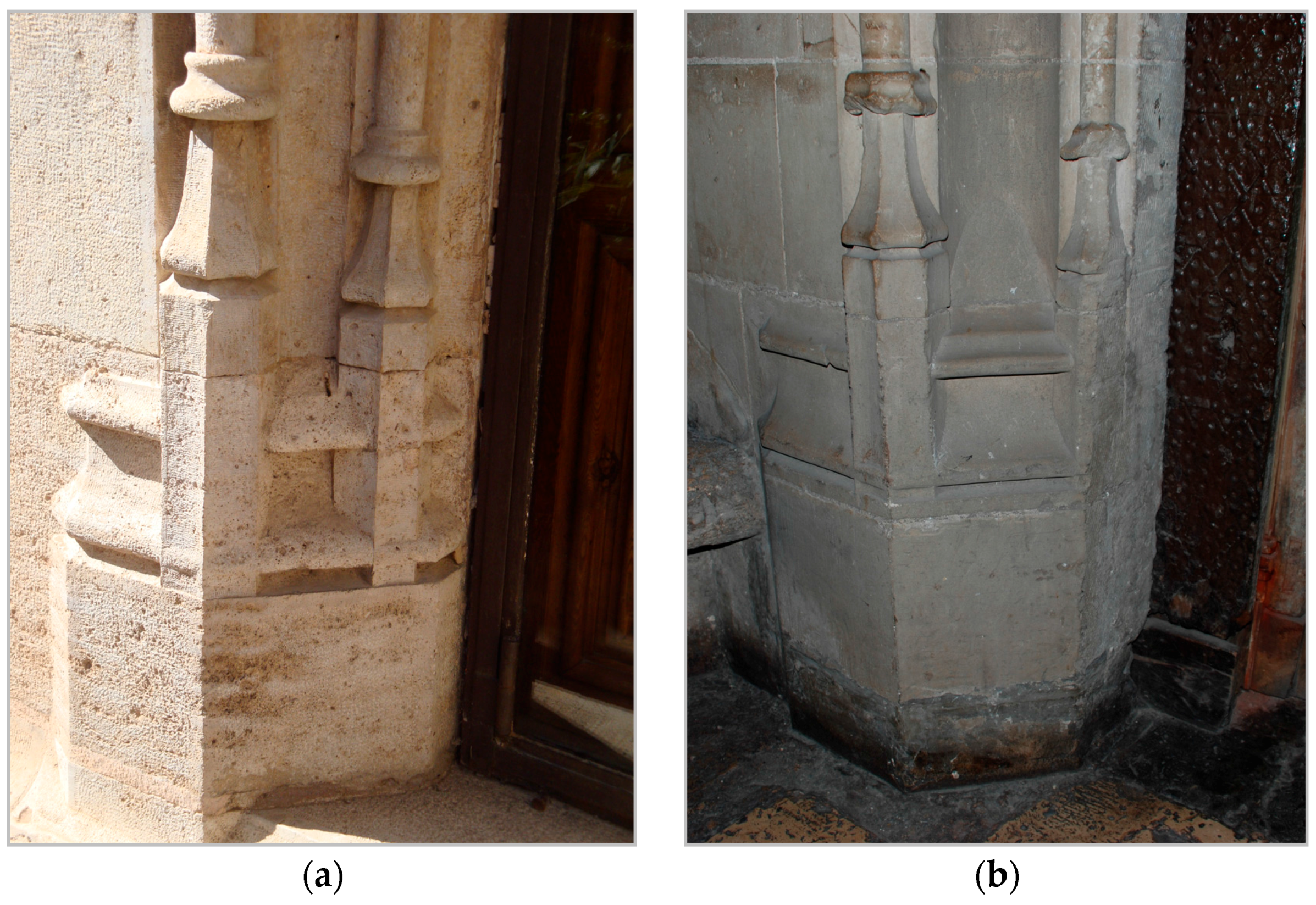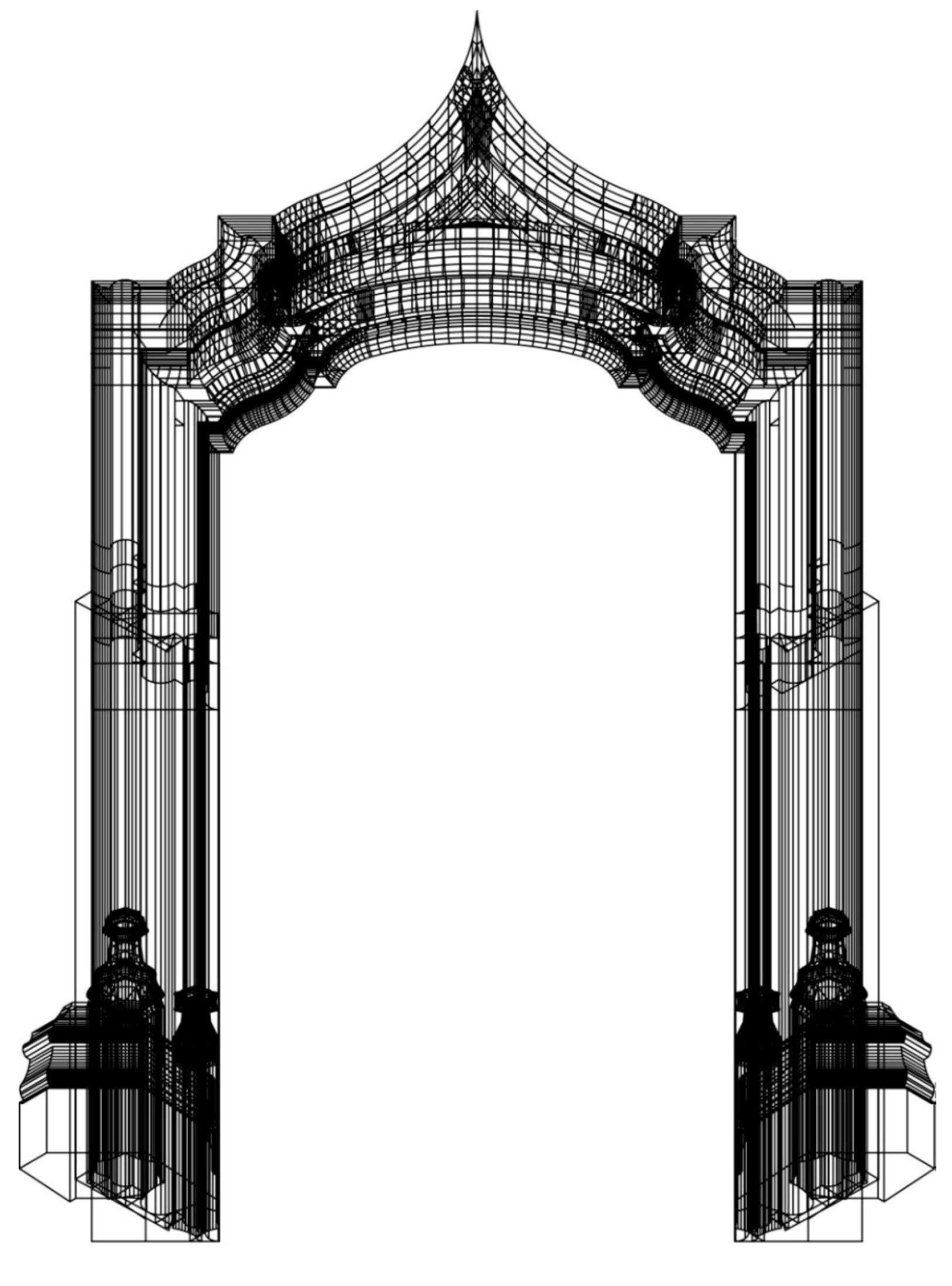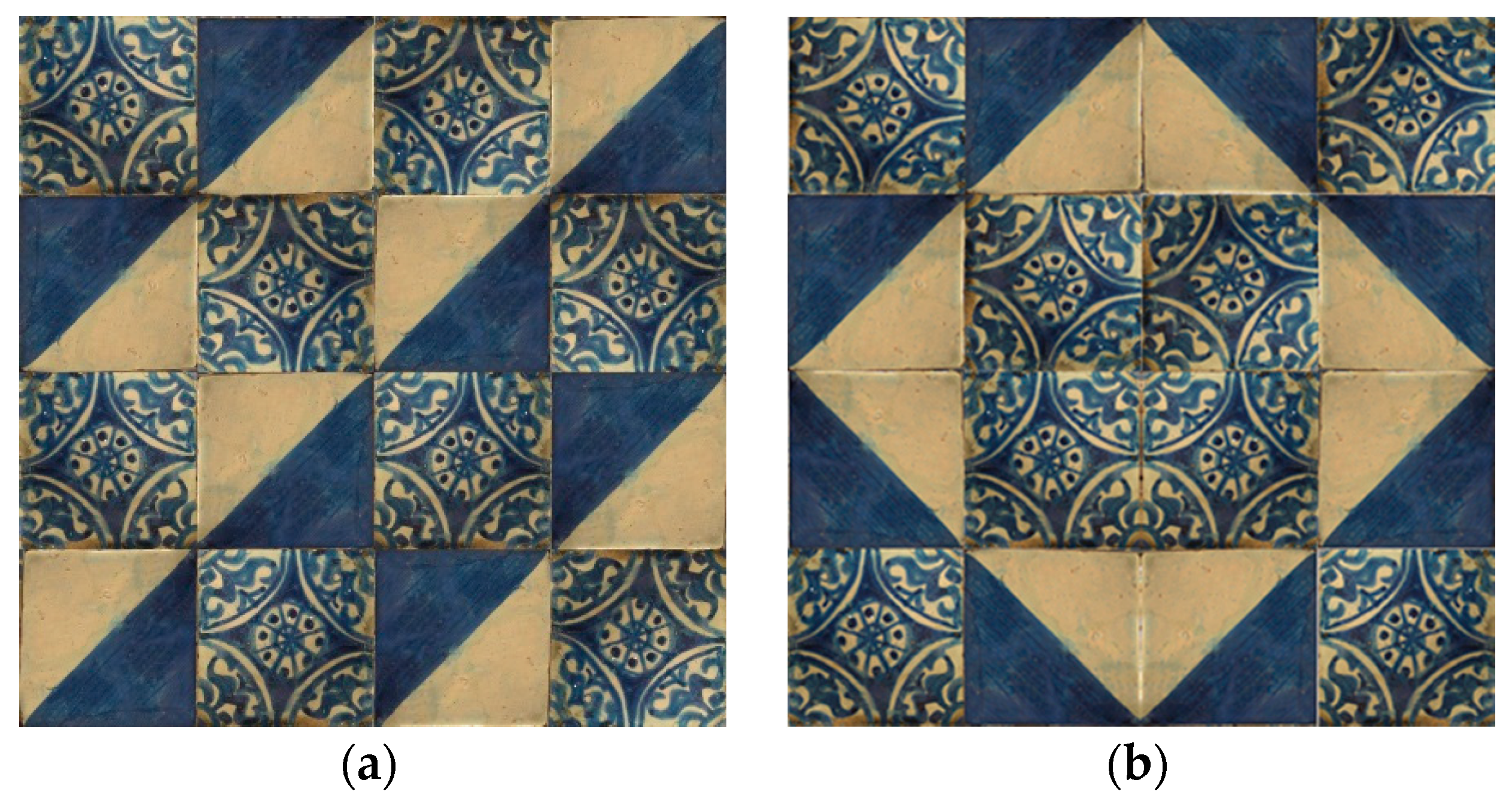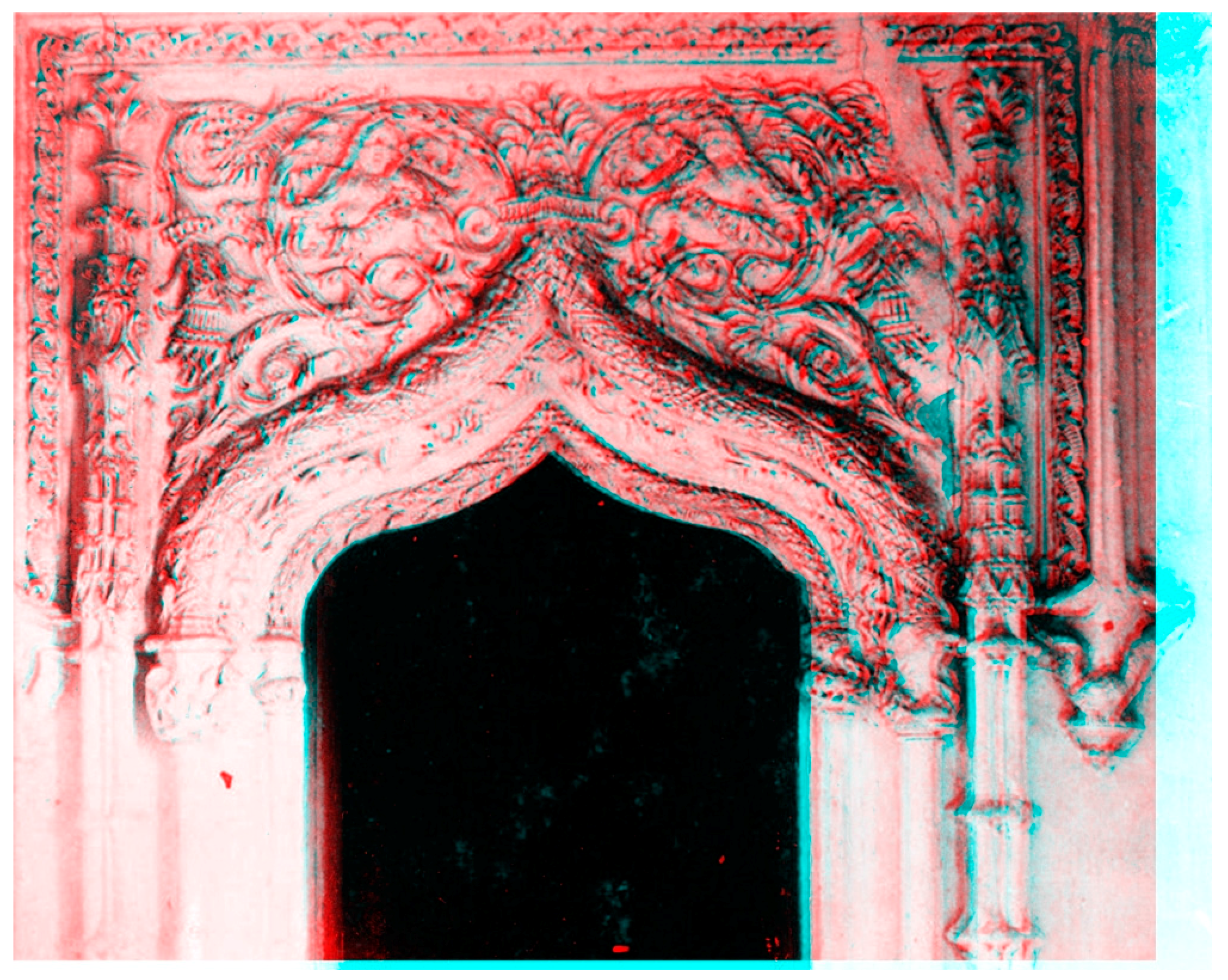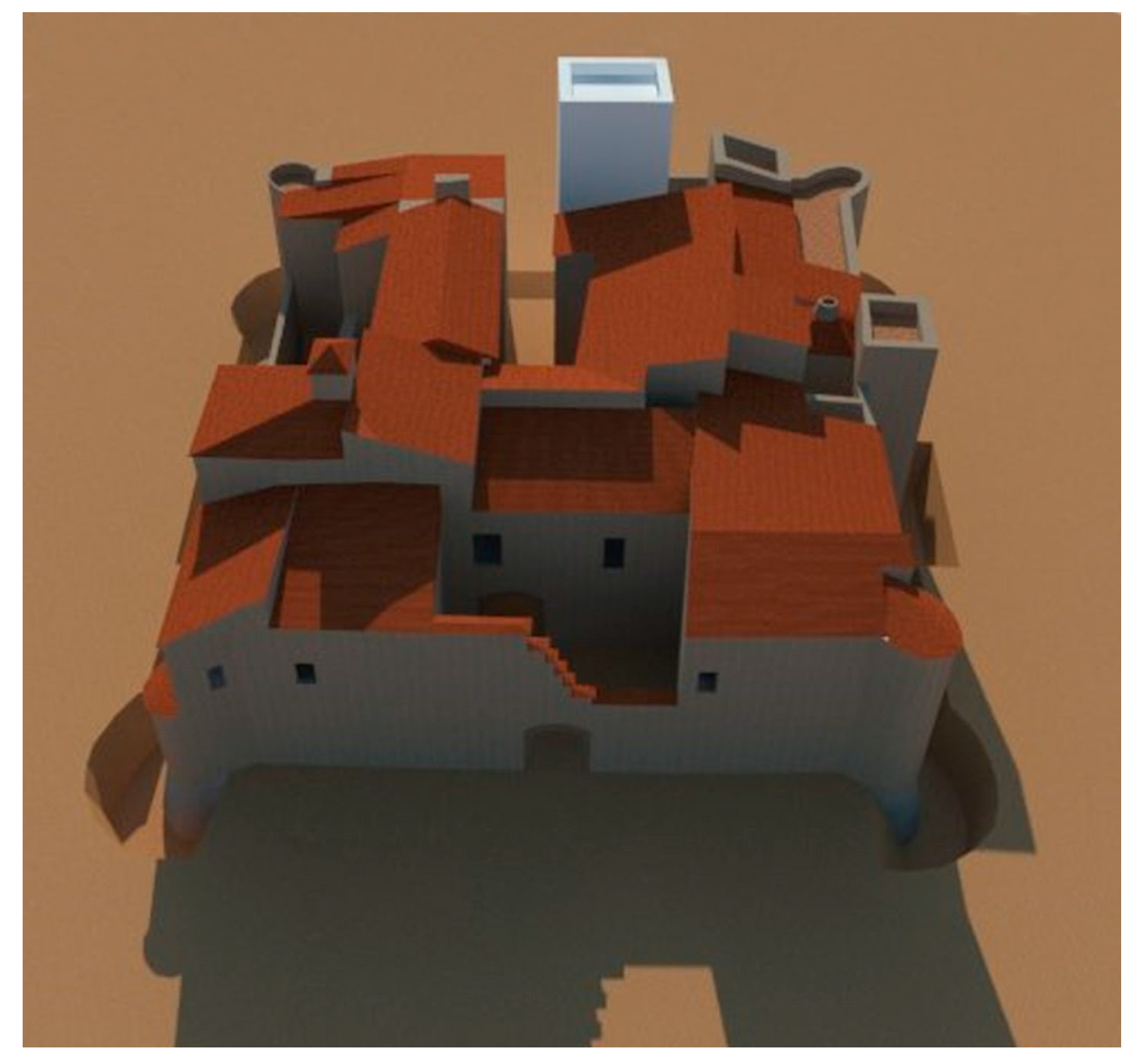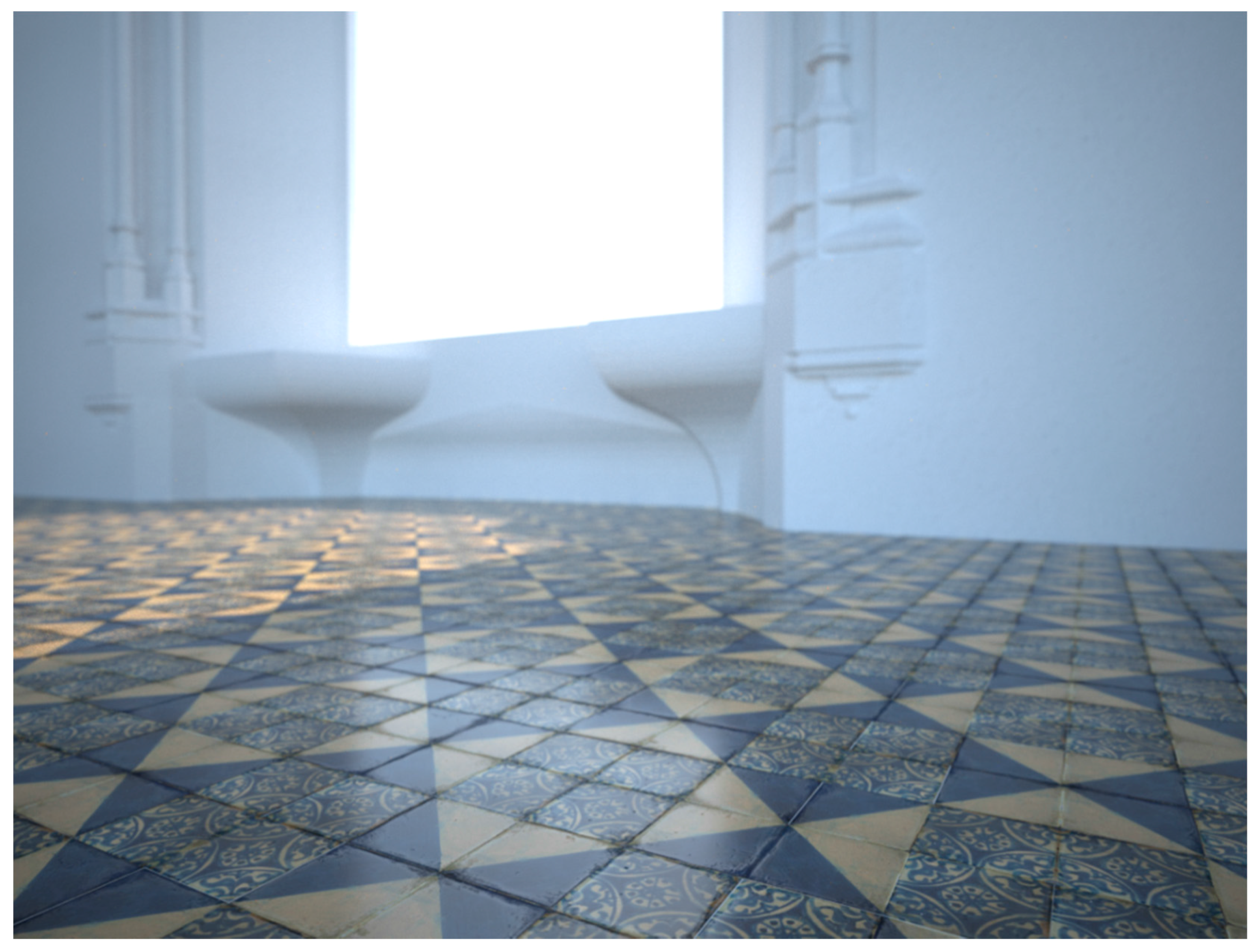1. Introduction
In 1932, José Mª Vidal published an article in the 11th edition of the scientific, literary and agricultural information weekly magazine Patria Chica [
1], in which he reports that, during the night of 19 January 1932, the main and second floors of the west side of the Palace collapsed because of the rain. The government administration had been informed because the Palace was already a National Monument at that time, and the building was visited by the provincial architect D. Luis Albert together with other technicians. Although at the date of this article the definitive technical report had not been issued, everything indicated that it would recommend the demolition of the parts that threatened ruin, because they consider it was impossible its restoration.
The article criticized the dismantling works and mercantilism of the Palace by its former owners and the lack of interest in the preservation of artistic and cultural heritage at that time. It also documents that the origin of the Palace might be the “Torre Maestral” or “Torre del Homenaje”, an imposing defensive tower of 120 spans’ height (27.6 m.) located on the lots of houses of numbers 18 and 20 on Palacio Street and numbers 10, 12 and 14 on Torres Street. This tower was demolished in 1882 to open Palacio Street. According to the document, on that date the two marble slabs dated in 1545 and 1546 already cited by other authors and referring to the fortification of the Palace at the time of Francesc de Centelles, 3rd Oliva’s Earl were kept in the Palace, although outside its original location. The document relates also the great artistic interest of the Palace for its style of transition between the Gothic and Renaissance.
In 1946, seven years after the ending of the Spanish Civil War, the architect conservator of monuments of the 4th Zone of the Ministry of Education, Alejandro Ferrant, developed the Project of Conservation of Decorative Elements of the Earls’ Oliva Palace, which is currently in the archive of the Institute of Cultural Heritage of Spain (IPCE), in Madrid (see
Figure 1) [
2]. This brief project consists of a memory, a budget and a floor plan of the remains of the Palace at that time. The purpose of the project was to replace the cover of the Weapons Room due to its poor condition, and the extraction of plaster decorative elements that remained in it, to be moved to a Valencian museum. This document provides us with invaluable information to determine the status of the remains of the Palace during its last days and helps to verify the dimensions of the Weapons Room and the surrounding rooms. Unfortunately, these works were not carried out, and some years later the remains of the Palace were completely demolished.
2. Background
When studying architectural heritage, it is necessary to follow the previous studies and/or the architectural surveys that have been carried out. Annex B of “The Charter of Restoration” (which sets out instructions for the execution of architectural restorations), written in 1972 [
3], established that the drafting of projects involving the restoration of a piece of architecture must be preceded by a careful study of the monument. These studies, known as previous studies, should be performed from different approaches so as to take into account aspects such as its position within the territorial context, either in the urban or in the rural setting, its typological aspects, formal properties and appearances, and the characteristics of its construction and the systems used, etc., both of the original building and of any additions and modifications carried out in later times. Moreover, previous studies should draw on bibliographic, iconographic, and archival research in order to collect as much historical data as possible.
Moreover, any restoration project should be based not only on a complete planimetric and photographic survey, which is also interpreted under the metrological aspect, but also on the regulating lines and systems of proportions. Likewise, it must include a careful study to verify the stability conditions.
A few years later, in 1998, a meeting of a group of Italian, French, and Spanish experts in Italy produced the document “Towards an Architectural Survey Charter” [
4], the aim of which was to define the topics to be included in a possible architectural survey charter. The document was approved in Naples in April 1999 and that same year its content was made public. In May 2000, the Spanish version of the letter was approved in Barcelona during the 8th Congress of Architectural Graphic Expression EGA 2000 and a few months later, in November of that year, the Declaration on architectural surveying, the “Rilievo Charter” [
5], which attempts to synthesize the previous document, was approved at the Sant’Angelo Castle in Rome.
As stated by Professor Antonio Almagro [
6]: “It is indeed in Italy where the concept of rilievo has been expanded to include everything that involves the knowledge and overall understanding of the building. We therefore believe that, in Spain, we should also extend the meaning of survey in a broader sense, to cover what until now have often been called “previous studies” because we consider that such activities do not necessarily have to be “prior” to anything; rather we are of the opinion that research aimed at furthering knowledge of our heritage, and in our particular case of its architecture, should be an autonomous activity or discipline, and not necessarily linked to restoration. A broad knowledge of heritage is the indispensable basis for successful conservation and involves far more than mere restoration, as this should be considered an exceptional activity”.
In conclusion, the Architectural Survey Charter takes over the premises reflected in the Restoration Charter, and both the previous studies and the comprehensive planimetric and photographic survey recommended in the Italian Charter of 1972 were renamed with the term Architectural Survey.
Indeed, any restorative or rehabilitative intervention on architectural and archaeological heritage requires, from our point of view, a survey which documents and provides rigorous evidence of its current state. The technologies used in these types of surveys oriented towards the geometric documentation of all kinds of heritage objects have advanced considerably in recent years. This has occurred despite the absence of paradigms on which to base the decisions concerning the protocols to be followed in the surveying process or the most appropriate techniques, depending on the type of object to be studied and the degree of definition required for each purpose.
In this sense, the decision regarding the technology to be used should comply with the aims defined by the nature of the documentation that is required. The level of requirement may vary depending on the agents involved in each intervention [
7]. Yet, as a reference to that level, we could take into consideration the fact that the different degrees of documentation should be proportional to the historical interest of the architectural or archaeological element under examination, as well as being appropriate to the purpose of the study.
This work has taken as a starting point the research work developed by E. Muller [
8,
9,
10] and other works related to the enhancement of heritage buildings and follows a work line based on the application of technological means in heritage graphic documentation. In this work line, there are other studies that have raised interesting results; some of them can be found in journals EGA, Virtual Archeology Review and Archeology of Architecture; and in the publications of Brusaporci [
11] and Amoruso [
12]. Some examples are the use of old photographs for the restitution of a ruined building by Angulo Fornos [
13] or the virtual reconstruction of a disappeared building using BIM modeling techniques [
14].
Some previous works, about physical models results have already been developed and presented at the 5th INTBAU International Event celebrated at Milan [
15].
3. The Graphic Legacy of the Centelles’s Palace of Oliva
3.1. The Testing Ground
This work focuses on the study and analysis of the graphic documentation carried out by the Danish architects Egil Fischer and Vilhelm Lauritzen between 1917 and 1920 on the Palace of the Earls of Oliva. This building was of the Flamboyant Late Gothic style with Mudejar elements that was developed in Spain in the mid-14th century. It also incorporated decorative elements of the first Spanish Renaissance [
8]. The remains of this Palace were demolished in 1950 due to its state of ruin.
3.2. Geographical, Historical, and Social Context
The Palace was located in the municipality of the same name, Oliva, in the region of La Safor, in the south of the province of Valencia, in the Valencian Region (Spain). Geographically, it is located at a latitude of 38°55′10′′ N and a longitude of 0°07′16′′ W (see
Figure 2). This Palace was the residence of the Centelles family, the lords of these lands, whose income was the second largest in the Kingdom of Valencia, due to the production of sugar cane and its manufacture, marketed throughout the Mediterranean Sea through the port of Oliva. The population of Oliva was divided into two neighborhoods: the “villa”, where the Christians lived, and the “Morería”, where the Muslim population lived until its expulsion, in 1609, by order of King Felipe III [
16].
The Palace of the Earls of Oliva was, at the height of its splendor, one of the largest and most important castle-palaces in the Kingdom of Valencia in the early 16th century. Its great promoter was the earl Serafin of Centelles, a humanist noble, who introduced the new trends of the Renaissance in his Palace. These works, dated between 1511 and 1515 [
10], had to continue after the revolts of the Germanías (1520), their main objective being to reinforce the security of the Alcázar. His nephew, Francesc Gilabert, continued these works.
After the death of Pere of Centelles in 1569 and the incorporation of the County into the Duchy of Gandia, the Palace ceased to have a continuous use. As a result, only minor maintenance work was carried out on it, thus allowing it to retain its original Renaissance style until its sale by the Osuna family in 1871. From that moment on the building began its decline, it was divided into parcels and the owners stripped it of everything that could be dismantled. When the Danish architect Egil Fischer visited the Palace for the first time in 1917, despite its poor state, it aroused a great interest in him owing to the uniqueness of its decorative elements.
In 1918, Fischer bought several sections of the Palace and, after submitting the Spanish Museum construction project to the Danish authorities and initiating the procedures for its construction, he went to Oliva to begin work on cataloguing and dismantling it with the help of Vilhelm Lauritzen. As part of his work, he made many scale plans of the most remarkable elements of the Palace, as well as drawing sketches and taking photographs [
9].
After a series of misfortunes and numerous complaints from the local authorities, the Palace was declared a national monument in 1920 and the exportation of its pieces was suspended. In 1932, due to some heavy rains, a part of the Palace collapsed. Despite some attempts to retrieve it, the remains of the piano Nobile of the Palace were demolished in the 50s, and all traces of this large building disappeared with them.
As of Lauritzen’s visit to Oliva in 1976, a link was established between him and the Mayor of Oliva, Salvador Cardona, with the aim of recovering the few remains of the Palace that were left in Denmark. In 1980 some parts of the Palace, including two meters of the frieze of the Hall of Weapons, went on auction in London and were acquired by the Hispanic Society of America (HSA).
From that moment on intense research work on the Palace was undertaken by Priscilla E. Muller, curator of the HSA. This work was carried out in connection with the town of Oliva, with Danish museums where part of the material was deposited, and with Vilhelm Lauritzen and Olga Fischer, who discovered in her house all the plans made by her husband and by the young Lauritzen. She eventually donated all this documentation to the HSA [
10].
Finally, after an agreement between the HSA and the Town Council of Oliva, all this documentation returned to Oliva in 2010 to become part of the cultural heritage of the town. This documentation of great architectural and heritage interest is currently digitized and has served as the basis for this work.
3.3. Architectonical Context
The Palace belonged to the category of stately houses, palaces or castle-palaces, from the Gothic period in the ancient Kingdom of Valencia, which was not unlike the others found in the Western Christian Mediterranean. They are organized around a central courtyard, and had four floors: the ground floor, the mezzanine, the main floor, or piano Nobile, and the attic (see
Figure 3). The staircase of the piano Nobile was situated in a corner of the courtyard. These palaces were usually built isolated from other buildings. Greater care had been taken with the main façade and had the best quality Ashlar masonry or rammed earth works.
On the ground floor, there was only a great doorway, which was the main access; the mezzanine had rectangular windows, and the piano Nobile used to have mullioned windows, with two to three small semicircular or trilobed arches that rested on columns. In the attic there was a series of small open arches to allow ventilation. The structure was completed with large eaves with carved beams. The composition of these façades did not follow any type of symmetry. In the courtyard there used to be a well and the ground floor was intended as a space to be used for service rooms, stables, storage, and the woodshed. From the lobby, another staircase led up to the mezzanine.
The piano Nobile looked out onto the courtyard through windows or a gallery of arches, and was where the nobles’ rooms were situated (see
Figure 4). Each of these rooms had a very high polychrome Mudejar carved ceiling. An indoor staircase provided access to the attic. This was where the servants lived, and it was also used to keep some food and as storage space. Behind the house there was an orchard-garden [
17].
A large number of these Valencian Gothic Palaces have been preserved, others are undergoing restoration, and some have totally disappeared. Several of them, besides the above-mentioned features, had defensive towers, some of which were protected by smaller square towers on their corners. Some examples of these so-called castle-palaces are located on Geldo Todolella, Sot de Ferrer, and Betxi in the province of Castellón, and Albalat dels Sorells (see
Figure 5), Alaquas, Benisanó, Oliva, and Lluxent in the province of Valencia [
18].
3.4. Scope of the Study
The aim of the present study was to analyze and study the graphic documentation produced by the two Danish architects between 1917 and 1920, consisting of the following documents:
All these documents have been digitized, which allows for better accessibility and facilitates both their classification and their later analysis and study. The documents have been photographed with a geometric scale and a chromatic reference scale, which makes their subsequent scaling easier.
The notebooks measure 11 × 17 cm, and have hard blue cardboard covers. The pages have a micro-perforation on one edge so that they can be cut or torn out from the notebook. The contents are handwritten notes and pencil drawings, including sketches of different architectural elements, such as doorways, arches, vaults, beams, coffered ceilings, stairs, carpentry, flooring, moldings, etc. These sketches also have annotations written in Danish. Likewise, there are sheets with measurements, lists of materials, addresses, bibliographic citations, etc. [
19,
20].
The blueprints are made up of 112 plans, mostly pencil-drawn, although some were done in ink. Each one of them is numbered according to the following code: MAO. APD [
21]. Egil Fischer and Vilhelm Lauritzen. LAXXXX. They contain drawings of the piano Nobile, and the roof plan of the Palace, as well as plans of coffered ceilings, vaults, arches, portals, windows, and other unique architectural elements of the piano Nobile of the Palace. One of the roof plans has a graphic scale, and some of the others show the dimensions, while others do not. In most plans of the portals, windows, and arches we have a main sheet drawn in greater detail and another traced on onionskin paper that seems to be a copy of the first offering details of how the architectural elements were to be dismantled before subsequently being shipped for reassembly in Denmark [
22].
The graphic documentation of the Palace that was retrieved and stored in the Archaeological Museum of Oliva includes two photo albums: the Large Photo Album and the Small Photo Album [
23,
24]. In them, we can find general photographs of Oliva and of the Palace, photographs of their unique architectural elements, pictures of other reference buildings, and photographs of the land in Denmark, where Fischer aimed to build the Spanish Art Museum which would house the disassembled pieces of the Palace. These photographs are accompanied by texts in Danish. All this photographic material has an untold value when trying to understand and analyze what this building was like [
25].
The elevations views of the blueprints, sketches and pictures has allow us to define the elevation of the portals and windows, the cross section views of blueprints and sketches have permit us to define the moulds of the arches and jambs (see
Figure 6). The lack of detail for the lower plinth and small bases of portals and windows in the documents makes it advisable to draw on the documentary material of other similar portals and windows such as La Lonja and the Cathedral of Valencia (see
Figure 7).
3.5. Approach
The main objective of this work has been to develop a graphic representation of some of the architectural elements of the Palace of the Earls of Oliva based on the graphic documentation that has been retrieved: plans, sketches, and photographs. After ordering and classifying this information, it was analyzed and studied. Likewise, we have also used historical and bibliographical references as well as similar physical models that have helped us to interpret and define these elements from a formal and stylistic point of view.
As a result of this work, we propose another twofold aim: on the one hand, its scientific diffusion in specialized media for its future study by other researchers and, on the other, the cultural diffusion of this National Monument, now disappeared, through 3D virtual reconstructions. In addition, there will be a subsequent phase of the production of scale models that afford us an effective visualization of certain elements of the building so that they can be understood by all kinds of users. Another objective is to enhance the adaptability of certain elements with the purpose of allowing people with functional diversity and lack of visual perception to enjoy this heritage building through the sense of touch.
The starting point of this work is the graphic material produced by the Danish architects Fischer and Lauritzen. Once the existing graphic documentation of each architectural element has been analyzed, the plans and photographs are rectified and scaled in order to be able to dimension those elements that did include measurements in their drawings, and then draw the pieces following the pre-established methodology. Photogrammetric rectification ASRix software has been used to rectify both photographs and plans (see
Figure 8). This software allows us just to rectify elements that are in the same plane; therefore, in the case of photographs, it has been only possible to obtain the inside line contour of the portal. Once the images and plans had been rectified, they were then scaled in a CAD tool (AutoCAD 2012, Autodesk, San Rafael, CA USA), with the help of dimensions obtained from the original drawings and sketches [
26].
4. Results
Once all the graphic documentation had been classified and analyzed, some of the elements of the Palace have been recovered graphically through different processes of graphic restitution, based on the original documents. The study of real study cases has helped us to get a deep knowledge of these gothic architectonic elements that allow us to fill the lacks of information found in the old graphical documentation. We will present some examples according to the different techniques used and the graphic material obtained.
This research work is part of the doctoral thesis of Professor Martínez-Moya, some of whose previous works have already been published. The main innovation of this work is to present globally all the graphic techniques used for the graphic recovery of some pieces of the Palace, and to reconstruct and visualize in a graphic way one of the main Halls with all their architectural elements starting from the recovered graphic documentation and some physical testimonies, allowing a holistic view and an architectural recovery of the now-disappeared Palace.
4.1. 2D Blueprints
Most of the elements that have been graphically restored are portals and windows of the Palace. Starting from the initial documentation, a graphic process has been carried out in order to obtain some views of the pieces in dihedral projection: elevation, and horizontal and vertical sections, as well as details of the remarkable elements (bases) (see
Figure 9). For this purpose, a CAD tool has been used, as well as photogrammetric rectification software (AutoCAD 2012, Autodesk, San Rafael, CA, USA &. ASRix Digital Image Rectifier v2.Beta,
http://nickerson.icomos.org/asrix/).
4.2. 3D Pieces
Given the geometrical complexity of the pieces, and in order to be able to define them perfectly, some of them were modeled in 3D. This work was done with the help of CAD tools, starting from the orthogonal views of the individual components by extrusion and rotation of the different elements and moldings that form the piece. They were then put together and assembled so as to obtain the common solid of the piece. This is a complex process due to the large number of elements that make up each of the pieces (see
Figure 10).
4.3. Graphic Restitution of Hall 12
Hall 12 was chosen as a study case because of its large dimensions, the singularity of its coffered ceiling, and because it has one of the most characteristic ogee arch portals of the Palace, Portal 12. This work allows us to visualize, analyze, and understand this architectural space as a whole in a virtual way based on the study of its parts.
The hall was located, like the other noble rooms of the Palace, on the main floor (see
Figure 11). With its large dimensions, its Late-Gothic portals and its rhombic coffered ceiling it was, without a doubt, one of the most outstanding halls in the Palace, together with the Hall of Arms. Therefore, it was documented almost completely by the Danish architects [
27].
Once each of the elements had been drawn in three dimensions, they were placed in their actual position to produce a CAD file containing both the 3D dimensions of the room and all the three-dimensional elements in their positions. The dimensions of the room were obtained by contrasting the blueprints of the coffered ceiling with the roof plane LA1106, which contains a graphic scale. To locate the portals and the window we started out with their position on the main floor plan LA1109 [
22]. The height of the room was determined by taking the proportion of the height of Portal 12 with respect to the total height of the room based on picture No. 77 [
23]. The results of these calculations yielded a total height of the wall of 5.60 m.
Although we do not have any specific information about the design of the flooring, we know that it was covered with white tiles decorated in blue. From this information and with the aim of obtaining a real idea of what the hall could have been like originally, two hypotheses addressing the graphic restitution of the flooring were posited based on the original flooring of the Palace located in the Tower of the Comare, today exhibited in the Archaeological Museum of Oliva. Hypothesis 1 corresponds to the original design of this flooring as it was found there, and Hypothesis 2 was developed by producing a new design based on the same pieces but emulating the flooring of the Golden Halls of the Generalitat Palace, in Valencia (see
Figure 12). In addition to inserting the rectified images of the original flooring, it has been textured to give it the irregular appearance that characterized this kind of hand-made tile flooring.
Once all the information had been introduced into the Maxwell rendering software, different views of the hall were obtained and a video of its interior was produced to provide us with a view of the entire Hall (see
Figure 13 and
Figure 14).
4.4. Anaglyphs
To create an anaglyph, two photographs taken at the same time are needed, to ensure they have the same light conditions and layout. In addition, the two photographs should focus on the same object, moving the camera sideways between 3 and 5 cm to take the second photograph (the distance between human eyes).
In the case of the photographs taken by Fischer, we have just a single photograph of most architectural elements, and only in some cases do we have two pictures of the same element taken from a similar viewpoint. We have therefore tried to obtain anaglyph images from these pairs of images, even though they were not taken at the same moment, using Anaglyph Maker software (Anaglyph Maker 1.08, free software,
https://anaglyph-maker.en.softonic.com) (see
Figure 15).
4.5. Physical Models
In the field of architecture, several studies on the use of architectural tactile models produced through 3D printing have been carried out, such as those made by Voigt & Martens [
28]. From the vast number of digitized buildings belonging to architectural heritage, it is possible to develop tactile models oriented to everyone and especially to people with visual disabilities. Their use facilitates the understanding of architectural elements and spaces [
12].
The physical models are created using different rapid prototyping techniques by the method of additive manufacturing, (AM), known as 3D printing. During the process of manufacture or construction of its parts, the material is deposited slowly so that it progressively creates the geometry of the piece; they are also known as layered manufacturing techniques [
15]. Three printing techniques were used: fused deposition modeling (FDM), stereolithography (SLA), and powder printing (3DP) (see
Figure 16).
4.6. Virtual Models
In the case of historical buildings, a part of which has disappeared or has been damaged, this can be restored virtually and viewed using such tools. The result is an effective vision of them that is close to the real element obtained by applying different textures and searching for viewpoints that are similar to those of a real view, and which close the gap between the virtual space being represented and the original architectural space in an effective and sustainable manner [
29]. This kind of graphic restitution can be applied not only to a single building in isolation, but also to its entire urban setting or surrounding landscape [
30]. The same process allows us, for example, to use virtual means to situate the Palace of Oliva within a modern-day urban environment and to analyze the result from the point of view of urban and landscape planning.
Thus, based on these premises and the existing graphic material (plans of the layout of the Palace, roof plans, sketches of the floors and façades, general and detailed photographs of the outside, as well as the written testimonies that define some of its elements), a virtual model of the outside of the Palace was created with the aim of reproducing what it looked like in 1917 when Fischer visited it for the first time. It is not a rigorous scientific model, as many data are missing, although in such cases attempts have been made to offset this drawback using the complementary information available. The result of the work is a preliminary conceptual virtual model that enables us to understand this great Palace as a whole (see
Figure 17).
5. Conclusions
The documents drawn up by Fischer and Lauritzen were produced with the aim of restoring the building, although not in the sense that we understand this concept today. Nowadays, we would perform a graphic survey of the building with the purpose of recovering it by restoring, reconstructing or consolidating it at its original location.
For some authors [
31,
32], the case of the Palace of Oliva is an example of the plundering of architectural heritage and of the “elginism” [
33] carried out in Spain up until the end of the twentieth century [
31]. It is hardly surprising that the building was added to the catalog of monuments that have disappeared in the Valencian Region [
34].
However, Fischer was convinced that the only way to save that old Palace, sold by its owners, divided into pieces, and with many of its treasures dismantled, was to disassemble it piece by piece and to rebuild part of its halls in a new building in Denmark. His plan was driven by the twofold aim of saving the valuable architectural elements that were still conserved, while at the same time allowing Danish architecture students to be able to study old Spanish architecture without the need to travel abroad [
35].
Paradoxically, time has confirmed Fischer’s theories about the conservation of the Palace, because, despite being catalogued as a National Monument in 1920, the authorities of that time did nothing to preserve the remains of the building, and nowadays it has almost completely disappeared.
If we analyze the Architectural Survey Chart, we notice that the Danish architects performed a real architectural survey of the Palace with the technical tools of their time and, in addition, Fischer took great pains to look for bibliographical documentation of the Palace with the aim of contextualizing it [
19,
20]. The graphic documentation carried out by E. Fischer and V. Lauritzen was produced almost a century before the publication of the document, but follows its principles, thus allowing us to know, study, disseminate, and enjoy this monument, and even making it possible to restore some of its parts. Therefore, we can say that they really did manage to preserve much of this magnificent Palace thanks to their documentation work, although not in a physical sense, but in a documental way (see
Figure 18).
The large amount of graphic documentation developed by Fischer and Lauritzen between 1917 and 1920 has allowed us to study some of the most unique elements of the Palace of the Earls of Oliva, while also encouraging us to try to decipher certain keys of the building, such as its origin, authors, metric, layout, and architectural composition.
In the process of graphic restitution, we have shown that it is possible to carry out a rigorous graphic reconstruction of some architectural elements of the Palace, allowing for a hypothetical physical reconstruction. The 3D modeling of its elements offers multiple options for visualization and reconstruction through both virtual and physical models. As a result, the architecture of this Palace can be brought closer to all kinds of audiences and its diffusion further promoted, not only in the scientific field, but also for cultural and heritage purposes, thus allowing the recovery of this National Monument, which no longer exists.
